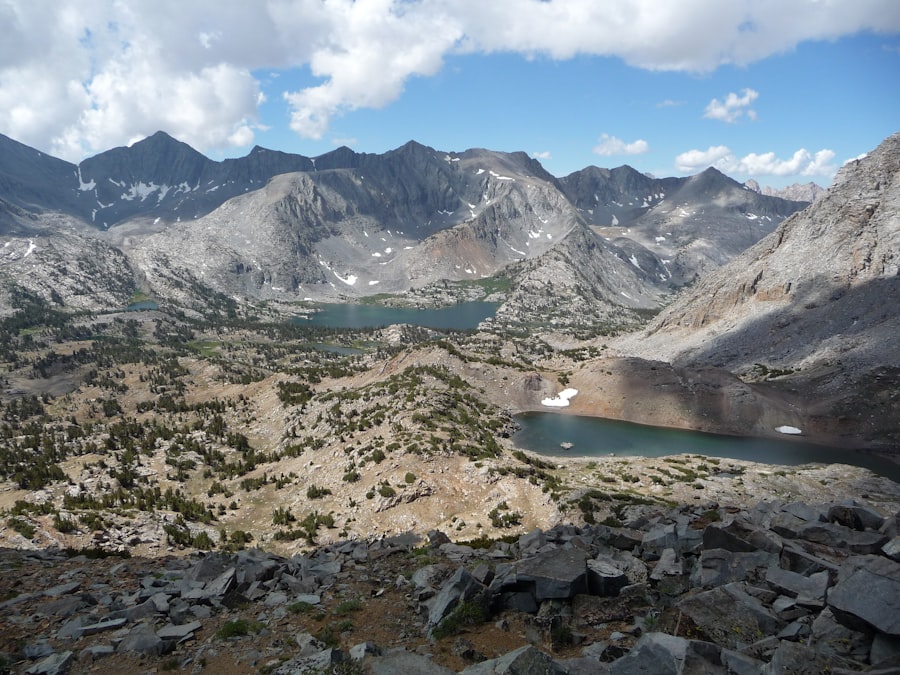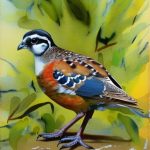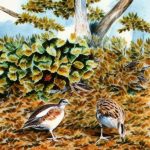Mountain quail, scientifically known as Oreortyx pictus, are a species of quail that are native to the mountainous regions of western North America. They are known for their striking appearance and elusive nature, making them a sought-after sight for birdwatchers and wildlife enthusiasts. Mountain quail are a unique breed of quail, distinct from other species due to their physical characteristics, habitat preferences, and behaviors. They are known for their distinctive call, which sounds like a series of clear, whistled notes, and their preference for living in dense brush and forested areas. Mountain quail are also known for their strong family bonds and social behaviors, often traveling in small groups or coveys. These birds are an important part of the ecosystem in their native range, contributing to the biodiversity and functioning of the mountainous habitats they inhabit.
Mountain quail are a popular game bird among hunters, prized for their challenging behavior and delicious meat. However, due to habitat loss and other threats, mountain quail populations have been declining in recent years, leading to concerns about their conservation status. Efforts are being made to protect and conserve mountain quail populations, but more research and conservation actions are needed to ensure the long-term survival of this unique and valuable species.
Table of Contents
- 1 Physical Characteristics of Mountain Quail
- 2 Habitat and Range of Mountain Quail
- 3 Reproduction and Nesting Behavior of Mountain Quail
- 4 Diet and Feeding Habits of Mountain Quail
- 5 Conservation Status and Threats to Mountain Quail
- 6 Importance of Mountain Quail in Ecosystems
- 7 FAQs
- 7.1 What is the breeding season for mountain quail?
- 7.2 How many eggs does a mountain quail typically lay?
- 7.3 How long does it take for mountain quail eggs to hatch?
- 7.4 What is the role of the male mountain quail during the breeding season?
- 7.5 At what age do mountain quail reach sexual maturity?
- 7.6 What are some common nesting habitats for mountain quail?
Key Takeaways
- Mountain quail are a unique breed of quail found in the western United States.
- They are known for their striking physical characteristics, including a distinctive crest and intricate plumage.
- Mountain quail prefer dense, brushy habitats at higher elevations, and can be found in the mountainous regions of California, Oregon, and Washington.
- Their nesting behavior involves building ground nests and laying a small clutch of eggs.
- Mountain quail have an omnivorous diet, feeding on a variety of seeds, fruits, and insects.
Physical Characteristics of Mountain Quail
Mountain quail are known for their striking appearance and unique physical characteristics. They are medium-sized birds, with a plump body and short tail. Their plumage is intricately patterned, with a combination of gray, brown, and chestnut colors that provide excellent camouflage in their forested habitats. The most distinctive feature of mountain quail is their striking facial markings, including a bold white stripe above the eye and a striking black patch on the throat. These markings make mountain quail easily recognizable and distinguish them from other species of quail.
In addition to their striking appearance, mountain quail also have unique physical adaptations that allow them to thrive in their mountainous habitats. They have strong legs and feet, which enable them to navigate through dense underbrush and rugged terrain with ease. Their short, rounded wings are well-suited for quick bursts of flight, allowing them to escape predators and navigate through the dense vegetation of their habitat. Overall, the physical characteristics of mountain quail reflect their adaptation to life in the rugged and challenging environments of western North America’s mountain ranges.
Habitat and Range of Mountain Quail
Mountain quail are primarily found in the mountainous regions of western North America, including parts of California, Oregon, Washington, Nevada, and Baja California in Mexico. They prefer dense brushy habitats, including chaparral, oak woodlands, and coniferous forests, where they can find cover and forage for food. Mountain quail are well-adapted to life in rugged terrain, often inhabiting steep slopes and rocky areas where they can find protection from predators and suitable nesting sites.
The range of mountain quail has been impacted by habitat loss and fragmentation due to human development, logging, and agriculture. As a result, mountain quail populations have declined in many parts of their range, leading to concerns about their long-term survival. Efforts are being made to protect and restore the habitats that mountain quail depend on, including the creation of protected areas and conservation initiatives aimed at preserving their mountainous habitats.
Reproduction and Nesting Behavior of Mountain Quail
Mountain quail are known for their strong family bonds and social behaviors, particularly during the breeding season. Males and females form monogamous pairs and work together to build a nest and raise their young. The breeding season typically begins in late spring or early summer when the weather is warm and food is abundant. Males perform elaborate courtship displays to attract females, including calling and strutting with their distinctive facial markings on full display.
Once a pair has formed, they work together to build a nest on the ground, usually concealed under dense vegetation or against a rock or fallen log for added protection. The female lays a clutch of 9-10 eggs, which she incubates for about three weeks while the male stands guard nearby. After hatching, both parents care for the chicks, leading them to food sources and protecting them from predators. The family group remains together throughout the summer, gradually dispersing as the young birds become independent.
Diet and Feeding Habits of Mountain Quail
Mountain quail are omnivorous birds with a varied diet that includes seeds, berries, insects, and green vegetation. They forage on the ground, scratching through leaf litter and soil to uncover food items. Mountain quail are particularly fond of acorns, which are an important food source in their habitat. They also feed on a variety of seeds from grasses and shrubs, as well as fruits and berries when they are in season.
During the breeding season, mountain quail may also consume more animal matter to provide protein for growing chicks. They will feed on insects such as grasshoppers, beetles, and caterpillars, as well as small reptiles and amphibians. Mountain quail are opportunistic feeders, taking advantage of whatever food sources are available in their habitat throughout the year.
Conservation Status and Threats to Mountain Quail

Mountain quail populations have been declining in recent years due to a combination of habitat loss, fragmentation, and other threats. Human development, including urbanization, agriculture, and logging, has resulted in the loss of suitable habitat for mountain quail across much of their range. Fragmentation of habitat has also isolated populations, making it difficult for birds to find suitable mates and maintain genetic diversity.
In addition to habitat loss, mountain quail are also threatened by predation from introduced species such as feral cats and foxes. These predators can have a significant impact on mountain quail populations, particularly during the breeding season when nests and young chicks are vulnerable. Climate change is also a concern for mountain quail, as it may alter the availability of food sources and suitable habitat in their range.
Efforts are being made to protect and conserve mountain quail populations through habitat restoration, predator control, and conservation initiatives aimed at preserving their mountainous habitats. Research is also being conducted to better understand the ecology and behavior of mountain quail so that effective conservation strategies can be developed.
Importance of Mountain Quail in Ecosystems
Mountain quail play an important role in the ecosystems of western North America’s mountain ranges. As seed-eating birds, they help disperse seeds from plants across their range, contributing to the regeneration of forests and other habitats. Their foraging behavior also helps to control insect populations, particularly during the breeding season when they consume large numbers of insects to feed their young.
Mountain quail are also an important food source for predators such as hawks, owls, and mammals, contributing to the functioning of food webs in their native habitats. Their presence is an indicator of healthy ecosystems with diverse plant communities that provide food and cover for a variety of wildlife species.
In addition to their ecological importance, mountain quail are also valued for their cultural significance and recreational value. They are a popular game bird among hunters, providing opportunities for outdoor recreation and contributing to local economies through hunting-related activities.
Overall, mountain quail are an important species in western North America’s mountain ecosystems, contributing to biodiversity and ecosystem functioning while also providing recreational opportunities for people who appreciate wildlife and outdoor activities. Efforts to protect and conserve mountain quail will benefit not only this unique species but also the diverse ecosystems they inhabit.
If you’re interested in learning more about mountain quail breeds, you might also want to check out this informative article on when guinea fowl lay eggs. Understanding the breeding patterns of different poultry species can provide valuable insights for anyone looking to raise and care for birds.
FAQs
What is the breeding season for mountain quail?
The breeding season for mountain quail typically occurs from April to July.
How many eggs does a mountain quail typically lay?
A female mountain quail typically lays a clutch of 9-10 eggs.
How long does it take for mountain quail eggs to hatch?
Mountain quail eggs typically take about 23-24 days to hatch.
What is the role of the male mountain quail during the breeding season?
The male mountain quail plays a role in building the nest and incubating the eggs, along with the female.
At what age do mountain quail reach sexual maturity?
Mountain quail typically reach sexual maturity at around 9-10 months of age.
What are some common nesting habitats for mountain quail?
Mountain quail often nest in dense shrubs, grassy areas, and brushy slopes in mountainous regions.
Meet Walter, the feathered-friend fanatic of Florida! Nestled in the sunshine state, Walter struts through life with his feathered companions, clucking his way to happiness. With a coop that’s fancier than a five-star hotel, he’s the Don Juan of the chicken world. When he’s not teaching his hens to do the cha-cha, you’ll find him in a heated debate with his prized rooster, Sir Clucks-a-Lot. Walter’s poultry passion is no yolk; he’s the sunny-side-up guy you never knew you needed in your flock of friends!







